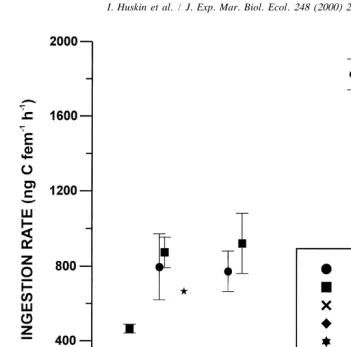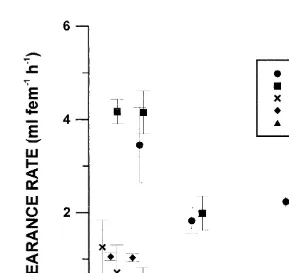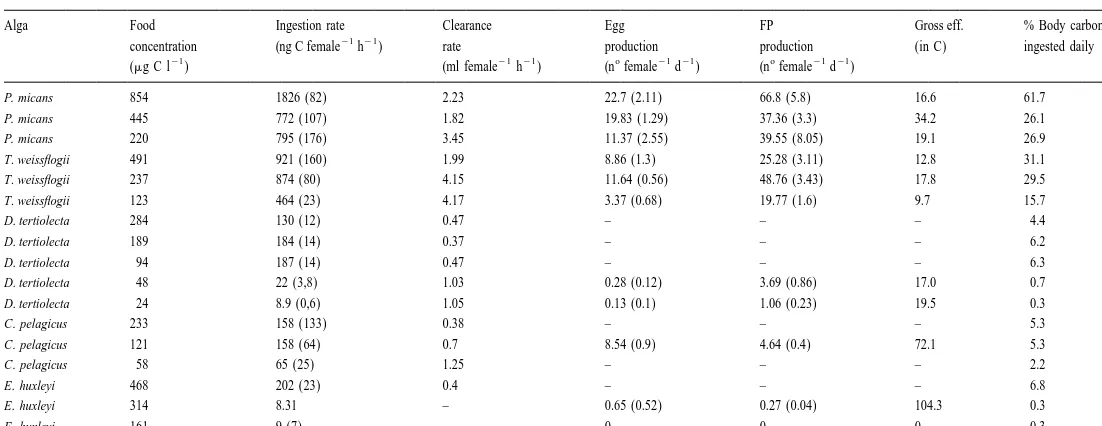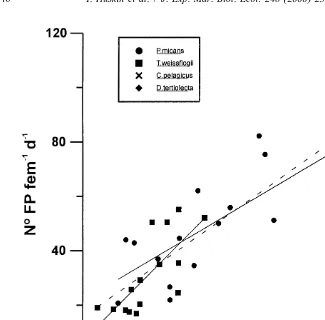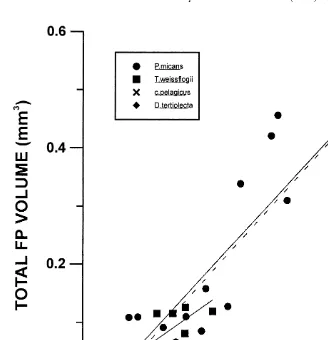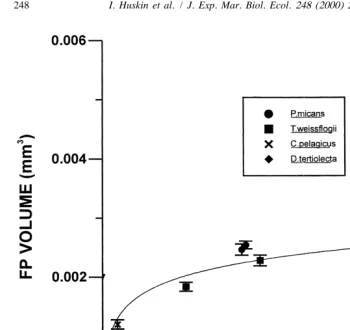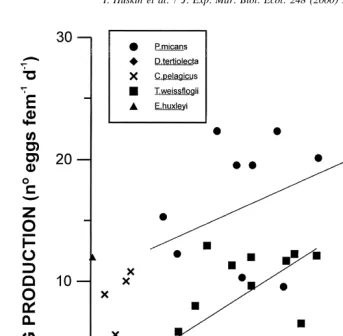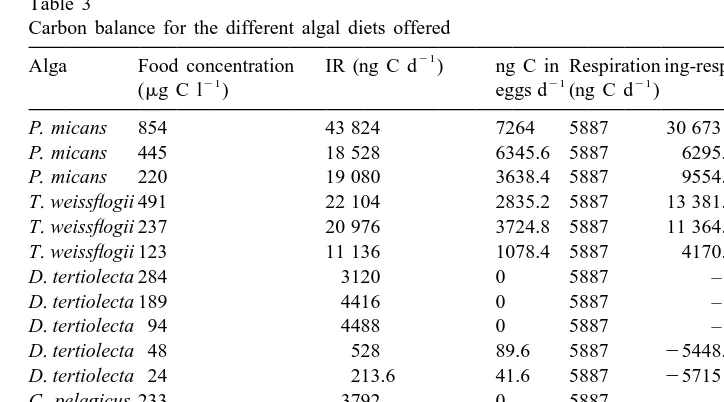L
Journal of Experimental Marine Biology and Ecology 248 (2000) 239–254
www.elsevier.nl / locate / jembe
Ingestion, faecal pellet and egg production rates of Calanus
helgolandicus feeding coccolithophorid versus
non-coccolithophorid diets
a ,* a ´ a b
´ ´
I. Huskin , R. Anadon , F. Alvarez-Marques , R.P. Harris a
´ ´ ´
Universidad de Oviedo, Department B.O.S. Area de Ecologıa, c /Catedratico Rodrigo Urıa s /n 33071
Oviedo, Spain b
Centre for Coastal and Marine Science, Plymouth Marine Laboratory, Prospect Place, The Hoe,
Plymouth PL1 3DH, UK
Received 14 April 1999; received in revised form 25 January 2000; accepted 1 February 2000
Abstract
Ingestion rates, faecal pellet and egg production were obtained in laboratory experiments with females of the copepod Calanus helgolandicus collected from the English Channel in November 1994. Five different algal monocultures were used as food: Prorocentrum micans (30mm ESD),
Thalassiosira weissflogii (13mm ESD), Dunaliella tertiolecta (7mm ESD), Emiliania huxleyi (5 mm ESD) and Coccolithus pelagicus (14mm ESD). Results obtained suggest the low ingestion efficiency of the copepod when feeding on coccolithophorids during late autumn–early winter. From the five species offered, only the largest non coccolithophorid Prorocentrum micans and
Thalassiosira weissflogii supported efficient feeding and calculated respiratory demand for C.
helgolandicus. Both coccolithophorids, irrespective of cell size, were ingested at very low rates
21
even when offered at high concentrations (233–468 mg C l ). Besides low ingestion, no egg production was found in the copepods fed with Emiliania huxleyi, although unusual high gross efficiency (reaching 72%) was obtained in experiments performed with Coccolithus pelagicus. The late seasonal timing of the experiments (November) could explain the low ingestion and egg production rates. 2000 Elsevier Science B.V. All rights reserved.
Keywords: Calanus helgolandicus; Coccolithophorids; Egg production; Faecal pellet production; Ingestion
1. Introduction
Coccolithophorids is a widely distributed phytoplankton group characterised by their
*Corresponding author.
E-mail address: [email protected] (I. Huskin)
calcium carbonate plates (coccoliths) surrounding the cell. The pelagic alga Emiliania huxleyi is the most widespread coccolithophore species and is considered to be the major producer of calcite in the biosphere. Extensive monospecific blooms of this alga have been described especially in mid-latitudes in both coastal and open oceanic waters.
6 2
These blooms have an average annual area of 1.4310 km of the world’s ocean
(Brown and Yoder, 1994), and can persist for 3–6 weeks reaching densities higher than
6 21
10 cells l .
Emiliania huxleyi has been largely studied in the last years in relation to the global
carbon cycle, due to the influence of calcite synthesis on the CO2 equilibrium in
seawater and the production of the climate-related dimethylsulfide (DMS). Apart from that, it has also been suggested that coccoliths are important in carbon flux to the deep
´
ocean, and the presence of coccoliths in sediment traps has been reported (Cadee, 1985). 21
Sedimentation rates of individual coccoliths are very low (10 cm d , Honjo, 1976), as
21
well as intact cells (1 m d , Smayda, 1971) so the formation of coccoliths or cell
21
aggregates, such as zooplankton faecal pellets with higher sinking rates (.100 m d ,
Harris, 1994) may be one of the most important mechanisms contributing to this flux. But the importance of this mechanism requires the existence of well-developed copepod populations, with animal abundance high enough to produce enough pellets to result in significant export. During monospecific Emiliania blooms, this alga may be the main source of food for zooplankton growth and reproduction. The present study analyses the capability of different coccolithophore diets (Emiliania huxleyi and Coccolithus pelagicus) to satisfy Calanus helgolandicus metabolic and reproductive requirements when offered as the only food, and also the capability to sustain high copepod abundance, when compared with non-coccolithophore diets such diatoms (Thalassiosira weissflogii ), or flagellates (Prorocentrum micans and Dunaliella ter-tiolecta).
2. Material and methods
Copepods were collected from net tows made off Plymouth (English Channel)
between 10th and 29th November 1994 using a WP2 net (60 cm diameter and 200mm
mesh). The cod end contents were transferred to the lab in surface seawater in less than 1 h. Ten Calanus helgolandicus females, actively swimming and apparently healthy (without broken appendices) were selected for each experiment and maintained for 24 h
in filtered (0.2 mm) seawater to clean their gut contents. Each female was examined
(dorsal view) under a Wild stereomicroscope (253) to ensure that ova were visible in
oviducts as opaque rows, extending to the last thoracic segment.
Phytoplankton monocultures were prepared with five algae species differing in
cell-size and carbon content as determined with Coulter Multisizer (70mm aperture) and
CHN analysis. Phytoplankton characteristics and concentrations used in the experiments are given in Table 1. Unialgal cultures, obtained from the Plymouth Culture Collection,
were grown at 158C in 2.5 l Erlenmeyer flasks using f / 2 medium (Guillard, 1975).
Cultures were incubated in an 18:6 h light:dark cycle at a light intensity of 100–200 E 22 21
m s . Only cultures in exponential growth phase were used. Five replicates and two
I. Huskin et al. / J. Exp. Mar. Biol. Ecol. 248 (2000) 239 –254 241 Table 1
Phytoplankton cell size (Equivalent Spherical Diameter), C–N content and concentrations used in the experiments
21 21
Alga Concentrations used ng C cell ng N cell ESD (mm)
21 (cells31000 ml )
Prorocentrum micans 0.12 ; 0.25 ; 1 1.68 0.21 30
Thalassiosira weissflogii 0.75 ; 1.5 ; 3 0.16 0.037 13
Coccolithus pelagicus 0.25 ; 0.5 ; 1 0.23 0.04 14
Dunaliella tertiolecta 3 ; 6 ; 12 ; 24 ; 36 0.007 0.0014 7
Emiliania huxleyi 12 ; 24 ; 36 0.013 0.002 5
for each food concentration. Before each experiment, 18 l of algae culture at the desired concentration (Table 1) were prepared, thoroughly mixed and checked for initial concentration using Coulter Multisizer. Culture was poured into 2.3 l glass jars and ten Calanus females were added. Jars were attached to a wheel that rotated at 1 r.p.m for 24
h at 158C to avoid phytoplankton sedimentation. Incubations were performed in
light–dark cycles of 12:12 h.
After 24 h, each jar was removed from the wheel and contents were gently siphoned
through a pipe into a vessel with a 30mm mesh false bottom where animals, eggs and
faecal pellets were retained. The mesh was maintained submerged in the water during all the procedure to avoid animal damage and pellet breakage. The filtrate was thoroughly stirred and three 20 ml subsamples were removed for Coulter Multisizer counts of final algal concentration. Animals were transferred to a beaker containing seawater, which facilitated easy removal of animals using a manual pipette. Animals were removed when swimming at the upper part of the beaker to avoid removing the pellets or eggs accumulated at the bottom. Animals were counted and transferred to fresh algal culture.
Eggs and faecal pellets were retained on a 30mm mesh and placed in 20 ml vials with 4
drops of Lugol’s solution to preserve the samples.
The same procedure was repeated for four days for each food concentration, considering the first three days as an acclimation period to experimental conditions. Eggs
and faecal pellets were counted and measured using an ocular micrometer at 4003
magnification. Volume was calculated assuming eggs to be spheres and faecal pellets to be cylinders. Carbon content of eggs was estimated assuming values proposed by
21
Kiørboe and Sabatini (1995) (0.32 mg C egg ).
Ingestion and clearance rates were calculated using the equation proposed by Marin et al. (1986) for experimental conditions where food concentration is lower than critical concentration, with phytoplankton growth in control bottles. We used this equation due to the difficulties to establish a proper critical concentration. In our experiments ingestion still increases above the critical concentration calculated using equations suggested by Huntley and Boyd (1984). Anyway, differences between the rates calculated using both equations were small.
21 21 21 21
I5Ingestion rate (cells female h ); F5clearance rate (ml female h ); V5jar
volume (ml); N5number of females; C05initial phytoplankton concentration in
21
experimental jar (cells ml ); Ct5final phytoplankton concentration in experimental jar
21 21
(cells ml ); t5time (h); k5cell growth coefficient (h ).
Gross efficiency of egg production and percentage of body carbon ingested daily were 21
calculated assuming 71.1mg C copepod as proposed by Kiørboe and Sabatini (1995)
for Calanus helgolandicus females.
3. Results
3.1. Ingestion rates
Ingestion and clearance rates obtained with the five algal species are plotted against food concentration in Figs. 1 and 2. Results suggest that Calanus helgolandicus only feed efficiently on two of the five algal species offered. Females fed the small coccolithophore E. huxleyi showed very low ingestion rates only apparent when offered
21
more than 468 mg C l . Rates with the other coccolithophore, Coccolithus pelagicus,
and the small non-coccolithophore Dunaliella tertiolecta were also very low. Only the copepods fed the medium and large sized non-coccolithophore alga Prorocentrum micans and Thalassiosira weissflogii showed high ingestion and clearance rates, reaching values 9 and 4 times higher than those obtained with Emiliania.
Average values of ingestion and clearance rates for each concentration are given in 21 21
Table 2. Emiliania huxleyi was grazed at maximum rates of 202 ng C animal h at a
21
food concentration of 468 mg C l . Lower maximum values were obtained for D.
tertiolecta and C. pelagicus although food was also offered at lower concentrations: 187
21 21 21 21 21
ng C animal h at 94mg C l for the small Dunaliella, and 158 ng C animal h
21
at 233 mg C l for Coccolithus. On the other hand, the dinoflagellate P. micans gave
21 21
the highest ingestion, with average maximum values of 1826 ng C animal h at 854
21
mg C l . The diatom T. weissflogii showed also high ingestion values: 921 ng C
21 21 21
animal h at 491 mg C l .
Although the data is not sufficient to obtain an accurate functional response, there is no sign of ingestion saturation in the experiments performed with E. huxleyi and P. micans. With these two algae the copepod could not achieve a maximum rate. It seems that saturation of ingestion is observed in T. weissflogii, D. tertiolecta and C. pelagicus,
21
at food levels of 237, 94 and 58 mg C l respectively.
Emiliania huxleyi was cleared at the lowest rates, with maximum values of 0.40 ml
21 21 21
animal h at 468 mg C l . Rates obtained for Coccolithus and Dunaliella were
21 21 21 21 21
respectively 1.25 ml animal h (at 58mg C l ) and 1.05 ml animal h (at 24mg
21
C l ). As found for ingestion rates, maximum clearance rates were obtained in
21 21
experiments performed with Prorocentrum and Thalassiosira: 3.45 ml animal h (at
21 21 21 21
220mg C l ) for the dinoflagellate and 4.17 ml animal h (at 123mg C l ) for the
diatom.
I. Huskin et al. / J. Exp. Mar. Biol. Ecol. 248 (2000) 239 –254 243
Fig. 1. Calanus helgolandicus ingestion rate (average and standard error) versus food concentration, with different monospecific algal diets.
daily by the animals fed with Emiliania huxleyi. Average values with this alga ranged between 0 and 6.8%. Low values were also found with the other coccolithophore and Dunaliella, 5.3% for the former and 0.3–6.3% for the latter. With Prorocentrum, ingestion represented 26–61% of body carbon while values of 15–31% were obtained with T. weissflogii.
3.2. Faecal pellet production
Fig. 2. Calanus helgolandicus clearance rate (average and standard error) versus food concentration, with different monospecific algal diets.
21
from an experiment at 314mg C l so only faecal pellets from P. micans, T. weissflogii,
C. pelagicus and D. tertiolecta, were measured and plotted in the graphs.
Linear relationships were found between number of pellets produced and ingestion rate, but better fits were found if we use total volume egested. Good fits were found in
2
the experiments performed with T. weissflogii (r 50.69, P50.003), D. tertiolecta
2 2
(r 50.73, P50.002) and P. micans (r 50.73, P50.00004) and no trend is found with
C. pelagicus, maybe due to the low number of data available. Regressions were tested
(ANCOVA) to determine statistical differences between them. No differences (P.0.1)
were found between linear regressions obtained with P. micans and T. weissflogii,
neither considering total pellets volume, nor number of pellets. Pooled regression equations are shown in Figs. 4 and 5. Statistical differences were found between both algae and D. tertiolecta.
21 21
Maximum average values found (Table 2) are 66.8 pellets animal d for P.
21 21 21 21
micans, 47.8 pellets animal d for T. weissflogii, 4.6 pellets animal d for C. 21 21
pelagicus, and 3.7 pellets animal d for D. tertiolecta. 2
A logarithmic relationship (r 50.94, P50.00004) was found between individual
I.
Average values (standard error in brackets) of ingestion rate, clearance rate, egg and faecal pellets production, gross efficiency and % of body carbon ingested daily for each food concentration used
Alga Food Ingestion rate Clearance Egg FP Gross eff. % Body carbon
21 21
concentration (ng C female h ) rate production production (in C) ingested daily
21 21 21 o 21 21 o 21 21
(mg C l ) (ml female h ) (n female d ) (n female d )
P. micans 854 1826 (82) 2.23 22.7 (2.11) 66.8 (5.8) 16.6 61.7
P. micans 445 772 (107) 1.82 19.83 (1.29) 37.36 (3.3) 34.2 26.1
P. micans 220 795 (176) 3.45 11.37 (2.55) 39.55 (8.05) 19.1 26.9
T. weissflogii 491 921 (160) 1.99 8.86 (1.3) 25.28 (3.11) 12.8 31.1
T. weissflogii 237 874 (80) 4.15 11.64 (0.56) 48.76 (3.43) 17.8 29.5
T. weissflogii 123 464 (23) 4.17 3.37 (0.68) 19.77 (1.6) 9.7 15.7
D. tertiolecta 284 130 (12) 0.47 – – – 4.4
D. tertiolecta 189 184 (14) 0.37 – – – 6.2
D. tertiolecta 94 187 (14) 0.47 – – – 6.3
D. tertiolecta 48 22 (3,8) 1.03 0.28 (0.12) 3.69 (0.86) 17.0 0.7
D. tertiolecta 24 8.9 (0,6) 1.05 0.13 (0.1) 1.06 (0.23) 19.5 0.3
Fig. 3. Number of faecal pellets produced by Calanus helgolandicus fed with different algal diet and 2
concentrations. Fits: P. micans: y50.023x121.866; n515; r 50.55; P50.00015; T. weissflogii: y5
2 2
0.0395x16.845; n515; r 50.55; P50.0025; D. tertiolecta: y50.173x20.331; n510 ; r 50.64; 2
P50.003; P. micans and T. weissflogii pooled regression (– – –) y50.027x115.56; n530; r 50.76;
P50.0001.
the experiments with the different algae and concentrations. Saturation volume was 3
0.0025 mm .
3.3. Egg production
The relationship between egg production and ingestion rate is shown in Fig. 6. No evaluation could be obtained with data from experiments performed with Emiliania due to the extremely low number of eggs produced. Maximum average values with this alga
21 21 21
were 0.65 eggs animal d at a 314mg C l concentration. We also found very low
egg production (even lower than with Emiliania) for copepods fed with Dunaliella. With 21 21
this algae production was nearly zero: 0.28 eggs animal d , so only enough data are
I. Huskin et al. / J. Exp. Mar. Biol. Ecol. 248 (2000) 239 –254 247
Fig. 4. Total volume of faecal pellets egested by Calanus helgolandicus fed with different algal diets and 2
concentrations. Fits: P. micans: y50.00021x20.0046; n515; r 50.73; P50.00004; T. weissflogii: y5
2 2
0.00013x20.0185; n510; r 50.69; P50.003; D. tertiolecta: y50.17x20.33; n510; r 50.73; P5 2 0.002; P. micans and T. weissflogii pooled regression (– – –) y50.0002x20.0582; n525; r 50.76;
P50.00001.
21
data from an experiment performed at 233mg C l are available, so we only show (Fig.
6) fits obtained with Prorocentrum and Thalassiosira. Good fits to a linear model were found when plotting egg production against ingestion rates in the experiments performed
2 2
with P. micans (r 50.33, P50.023) and T. weissflogii (r 50.49, P50.004), although
the P value obtained for P. micans makes this relationship to be considered carefully.
Both regressions were statistically different (ANCOVA, P,0.001).
Only copepods fed with P. micans, T. weissflogii and C. pelagicus produced an
appreciable number of eggs. The average values obtained for these algae (at food 21 21
concentration with maximum ingestion rates) are 22.7 eggs animal d with P.
21 21 21 21
Fig. 5. Calanus helgolandicus faecal pellet individual volume (average and standard error) versus ingestion 2
rate for four different algal diets. Fit: y50.00041 logx20.00054; n58; r 50.94; P50.00004.
Carbon in eggs / Carbon ingested) between 0.16 and 0.34 for P. micans, 0.09 and 0.12 for
T. weissflogii, and 0.72 for C. pelagicus (Table 2).
4. Discussion
I. Huskin et al. / J. Exp. Mar. Biol. Ecol. 248 (2000) 239 –254 249
Fig. 6. Egg production obtained for Calanus helgolandicus feeding at different concentrations of five 2
monospecific algal cultures. Fits: P. micans: y50.00663x110.447; n515; r 50.33; P50.023; 2
T.weissflogii: y50.00933x10.913; n515; r 50.49; P50.004.
this kind of grazing experiment it is suggested not to be a limiting factor (Kiørboe et al., 1985).
21
ml cleared daily in a 3–47 000 cells ml suspension. Harris (1994), in experiments
performed with Calanus helgolandicus and Emiliania huxleyi, found maximum values of
21 21 21
16 000 cells animal h at 24 000 cells ml . Our results with Emiliania are even
21 21 21
lower: 15 000 cells animal h at 36 000 cells ml . We didn’t find any previous data
for Coccolithus, but our results are also very low. Maximum values obtained with this
21 21 21
alga are 158 ng C animal h at 1000 cells ml . The effect of food concentration on
ingestion rates has been demonstrated for many phytoplankton and copepod species. We 21
did not observe any ingestion at food concentrations below 36 000 cells ml , however
Harris (1994) and Nejstgaard (1997) both found linear and exponential relationships between both parameters, with measurable ingestion below this concentration.
Nej-21
stgaard found saturation at food concentrations around 750 mg C l while Harris did
not find any saturation, but the maximum food concentration used was 24 000 cells 21
ml . Anyway carbon concentrations offered are higher than the maximum ones that the
copepod could find in the sea during most bloom situations. Usually natural coc-21
colithophorid concentrations are between 0.1 and 100 cells ml while in bloom
21
situations they can reach 1000–6000 cells ml (Head et al., 1998) although extremely
21
high values of 115 000 cells ml have been reported by Berge (1962) for Norwegian
coastal waters and fjords. We offered a maximum food concentration 6 times higher than usual concentrations in the sea, so higher rates found in the literature for this food concentrations (or even higher) should be considered carefully when compared to the sea, because copepods usually do not experience such concentrations.
There are many papers demonstrating the importance of food cell size in determining ingestion rates (Frost, 1972, 1977; Lam and Frost, 1976; Richman et al., 1977; Cowles,
¨
1979; Paffenhofer, 1984; Berggreen et al., 1988; Støttrup and Jensen, 1990; Nejstgaard et al., 1995). In the genus Calanus, Frost (1977) has suggested a lower threshold of
4–11 mm for the food to be efficiently ingested and Nival and Nival (1976) found
copepods unable to feed on particles smaller than 10 mm. Although not efficiently
ingested, particles smaller than 10 mm have been found in FP produced by Calanus
finmarchicus, so despite the small size, cells are ingested when abundant. Our results seem to confirm these previous findings. Calanus helgolandicus only fed efficiently when we offered medium-large algae. However, cell size is not the only factor determining low ingestion as Coccolithus pelagicus is larger than Thalassiosira, but is ingested at lower rates when offered at the same concentrations. Food quality has also been suggested to determine ingestion or rejection by copepods. Young (1994) suggests that coccoliths can inhibit copepod ingestion. Wolfe and Steinke (1996) suggest production of anti-predator metabolites related to DMS and Keller (1989) also suggested DMS as an agent which results in food rejection.
I. Huskin et al. / J. Exp. Mar. Biol. Ecol. 248 (2000) 239 –254 251
adapted to the available food. Nejstgaard et al. (1995) also found that ingestion by Calanus finmarchicus grazing on Emiliania huxleyi in laboratory experiments does not occur when experiments were performed during winter, at food concentrations similar or even higher than the ones we used. According to this importance of season, the highest feeding (and reproduction) rates was achieved on the dinoflagellate diet. Although this could simply be explained solely by the large size, this could be also an effect of a different seasonal copepod adaptation to this type of algae, which sometimes form blooms during fall and even later in the season in temperate waters.
Besides the low ingestion, we also found no egg production with Emiliania huxleyi, not even when offered at high concentrations. Despite the large number of published studies on the influence of diet on egg production by copepods, there are not so many using coccolithophorids as food. Even considering the extremely low ingestion found with this food, egg production is lower than expected from the high values found by
21 21
Nejstgaard et al. (1997) for Calanus finmarchicus (45 eggs animal d in laboratory
21 21
and 67 eggs animal d in mesocosm experiments). Probably, the late time of the
season, with the copepods approaching the end of their reproductive period is the origin of this low production. This could be also the explanation of why the egg production rates obtained with non-coccolithophore foods are lower than the ones found in
21 21
literature: 50 eggs animal d for Calanus pacificus fed with Thalassiosira weissflogii
21 21
(Runge, 1984), 50 eggs animal d for Calanus pacificus fed with Prorocentrum and
21 21 21 21
75 eggs animal d with Thalassiosira (Uye, 1996), 39 eggs animal d for
21 21
Calanus pacificus with Prorocentrum micans and 23 eggs animal d with Thalassio-sira weissflogii (Peterson, 1988). The risk of egg cannibalism in bottles without meshes must be considered, especially in the presence of less preferred food like coc-colithophorids. The methodology used could have contributed to the low apparent egg production rates obtained with this alga.
On the other hand, egg production found with Coccolithus is very surprising. Values obtained are very high if we consider that ingestion rates, in terms of carbon, were even lower than the ones found with Emiliania. No previous data have been found in literature with this alga, but probably chemical composition makes Coccolithus a very nutritional food in order to maintain secondary production. It has been suggested than high levels of n-3 PUFA and other lipids found in coccolithophorids (Pond and Harris, 1996) could represent a high nutritional value for reproduction (Nejstgaard et al., 1997). Anyway, discussion of results obtained with C. pelagicus may be taken carefully, due to the small number of experiments performed with this alga.
If we consider the ingestion rates observed in relation to the respiration requirements 21
(5.9 mg C d ) calculated using formulae proposed by Ikeda (1985) for a copepod of 71
mg C and a temperature of 158C, coccolithophorids do not supply enough carbon to
Table 3
Carbon balance for the different algal diets offered 21
Alga Food concentration IR (ng C d ) ng C in Respiration ing-resp-eggs % non
21 21 21
(mg C l ) eggs d (ng C d ) assimilated
P. micans 854 43 824 7264 5887 30 673 69.99
P. micans 445 18 528 6345.6 5887 6295.4 33.98
P. micans 220 19 080 3638.4 5887 9554.6 50.08
T. weissflogii 491 22 104 2835.2 5887 13 381.8 60.54
T. weissflogii 237 20 976 3724.8 5887 11 364.2 54.18
T. weissflogii 123 11 136 1078.4 5887 4170.6 37.45
D. tertiolecta 284 3120 0 5887 – –
D. tertiolecta 189 4416 0 5887 – –
D. tertiolecta 94 4488 0 5887 – –
D. tertiolecta 48 528 89.6 5887 25448.6 –
D. tertiolecta 24 213.6 41.6 5887 25715 –
C. pelagicus 233 3792 0 5887 – –
C. pelagicus 121 3792 2732.8 5887 24827.8 –
C. pelagicus 58 1560 0 5887 – –
E. huxleyi 468 4848 0 5887 – –
E. huxleyi 314 199.44 208 5887 25895.56 –
E. huxleyi 161 216 0 5887 – –
efficiency found with Coccolithus. This value is much higher than that found in the literature not only for Calanus, but for other copepods fed with different diets as well. Stored lipids must sustain this high egg production; no egg production could be maintained with the carbon ingested when offered this alga as the only food. Further investigations will be required to understand the high nutritional value of Coccolithus related to secondary production. Only copepods fed with Prorocentrum and Thalassio-sira have ingestion high enough to compensate respiration and to maintain the observed egg production.
Once respiratory requirements and carbon invested in eggs are discounted, we observed a positive balance in the experiments performed with Thalassiosira and Prorocentrum, but not with the other algae. If we assume that the copepod does not accumulate stores (it seems reasonable if it is producing eggs) and does not grow (we have selected adult females), the rest of the ingested carbon not respired and not converted in eggs, is not assimilated carbon and should be egested as FP. Considering the number and volume of FP egested in our experiments we obtain values of 0.07–0.09
23 23
mg C mm for pellets produced with Prorocentrum, and 0.1–0.13 mm for pellets
produced with Thalassiosira. These results are similar to those found by Andreassen et al. (1996) in Calanus pellets fed with natural suspensions and translates into values of 34–72% of non-assimilated carbon for Prorocentrum and 37–63% for Thalassiosira. For both diets higher assimilation is found at lower food concentrations suggesting copepod ingestion is more efficient when food is scarce. When abundant, it is ingested at higher rates but with lower assimilation.
I. Huskin et al. / J. Exp. Mar. Biol. Ecol. 248 (2000) 239 –254 253
early in the season, Nejstgaard (1997) found much higher ingestion (comparable to the ones we found with Thalassiosira or Prorocentrum) at double the concentrations of the maximum ones we used. During late autumn, Calanus helgolandicus should comple-ment its diet with non-coccolithophorid algae or with non algal food. Kleppel (1993) suggests the importance of diet diversity in copepod feeding. This effect of coc-colithophorid diets on Calanus helgolandicus feeding and reproduction suggests difficulties in the existence of well developed Calanus helgolandicus populations during monospecific blooms in this late season, so the potential role of this genera in carbon flux during such situations may be restricted.
Acknowledgements
Support for this study was provided by the European Commission, MAST II Programme, Contract MAST-CT92-0038. The authors are grateful to D. Pond and D. Lesly for their help in the design and performance of the experiments. We also thank R.
´ ´
Gonzalez-Quiros for his useful comments in the final redaction of the article. [RW]
References
¨
Andreassen, I., Nothig, E.-M., Wassmann, P., 1996. Vertical particle flux on the shelf off northern Spitsbergen Norway. Mar. Ecol. Prog. Ser. 137, 215–228.
Berge, G., 1962. Discoloration of the sea due to Coccolithus huxleyi ‘‘bloom’’. Sarsia 6, 27–40.
Berggreen, U., Hansen, B., Kiørboe, T., 1988. Food size spectra, ingestion and growth of the copepod Acartia
tonsa during development: implications for determination of copepod production. Mar. Biol. 99, 341–352.
Brown, C.W., Yoder, J.A., 1994. Coccolithophorid blooms in the global ocean. J. Geophys. Res. 99 (C), 7467–7482.
´
Cadee, G.C., 1985. Macroagregates of Emiliania huxleyi in sediment traps. Mar. Ecol. Prog. Ser. 24, 193–196. Cowles, T.J., 1979. The feeding response of copepods from the Peru upwelling system: food size selection. J.
Mar. Res. 37, 601–622.
Frost, B.W., 1972. Effects of size and concentration of food particles on the feeding behaviour of the marine planktonic copepod Calanus pacificus. Limnol. Oceanogr. 17, 805–815.
Frost, B.W., 1977. Feeding behaviour of Calanus pacificus in mixtures of food particles. Limnol. Oceanogr. 22, 263–266.
Guillard, R.R.L., 1975. Culture of phytoplankton for feeding marine invertebrates. In: Smith, W., Chaney, M.H. (Eds.), Culture of Marine Invertebrate Animals, Plenum Publishing, New York, pp. 29–60.
Harris, R.P., 1994. Zooplankton grazing on the coccolithophore Emiliania huxleyi and its role in inorganic carbon flux. Mar. Biol. 119, 431–439.
˜
Head, R.N., Crawford, D.W., Egge, J.K., Harris, R.P., Kristiansen, S., Lesley, D.J., Maranon, E., Pond, D., Purdie, D., 1998. The hydrography and biology of a bloom of the coccolithophorid Emiliania huxleyi in the northern North Sea. J. Sea. Res. 39, 255–266.
Honjo, S., 1976. Coccoliths: production, transportation and sedimentation. Mar. Micropaleont. 1, 65–79. Huntley, M., Boyd, C.C., 1984. Food limited growth of marine zooplankton. Am. Nat. 124, 455–478. Ikeda, T., 1985. Metabolic rates of epipelagic marine zooplankton as a function of body size and temperature.
Mar. Biol. 104, 1–11.
Kiørboe, T., Sabatini, M., 1995. Scaling of fecundity, growth and development in marine planktonic copepods. Mar. Ecol. Prog. Ser. 120, 285–298.
˚
Kiørboe, T., Møhlenberg, F., Riisgard, H.U., 1985. In situ feeding rates of planktonic copepods: a comparison of four methods. J. Exp. Mar. Biol. Ecol. 88, 67–81.
Kleppel, G.S., 1993. On the diets of calanoid copepods. Mar. Ecol. Prog. Ser. 99, 183–195.
Lam, R.K., Frost, B.W., 1976. Model of copepod filtering response to changes in size and concentration of food. Limnol. Oceanogr. 21, 490–500.
Marin, V., Huntley, M.E., Frost, B., 1986. Measuring feeding rates of pelagic herbivores: analysis of experimental design and methods. Mar. Biol. 93, 49–58.
Nejstgaard, J.C., 1997. Food web dynamics in flagellate-dominated marine environments. Trophic interactions between haptophytes, calanoid copepods and microzooplankton. PhD Thesis. Department of Fisheries and Marine Biology. University of Bergen, Norway.
Nejstgaard, J.C., Gismervik, I., Solberg, P.T., 1997. Feeding and reproduction by Calanus finmarchicus, and microzooplankton grazing during mesocosm blooms of diatoms and the coccolithophore Emiliania huxleyi. Mar. Ecol. Prog. Ser. 147, 197–217.
˚ ¨
Nejstgaard, J.C., Bamsted, U., Bagoien, E., Solberg, P.T., 1995. Algal constraints on copepod grazing. Growth state, toxicity, cell size, and season as regulating factors. ICES. J. Mar. Sci. 52, 347–357.
Nival, P., Nival, S., 1976. Particle retention efficiencies of an herbivorous copepod, Acartia clausi (adult and copepodite stages): effects on grazing. Limnol. Oceanogr. 21, 24–38.
¨
Paffenhofer, G.-A., 1984. Food ingestion by the marine planktonic copepod Paracalanus in relation to abundance and size distribution of food. Mar. Biol. 80, 323–333.
Peters, R.H., Downing, J.A., 1984. Empirical analysis of zooplankton filtering and feeding rates. Limnol. Oceanogr. 29, 763–784.
Peterson, W.T., 1988. Rates of egg production by the copepod Calanus marshallae in the laboratory and in the sea off Oregon, USA. Mar. Ecol. Prog. Ser. 47, 229–237.
Pond, D., Harris, R.P., 1996. The lipid composition of the coccolithophore Emiliania huxleyi and its possible ecophysiological significance. J. Mar. Biol. Assoc. U.K. 76, 3.
Richman, S., Heinle, D.R., Huff, R., 1977. Grazing by adult estuarine calanoid copepods of the Chesapeake bay. Mar. Biol. 42, 69–84.
Roman, M.P., Rublee, P.A., 1980. Containment effects in copepod grazing experiments: a plea to end the black box approach. Limnol. Oceanogr. 25, 982–990.
Runge, J.A., 1984. Egg production of the marine, planktonic copepod, Calanus pacificus Brodsky: laboratory observations. J. Exp. Mar. Biol. Ecol. 74, 53–66.
Smayda, T.J., 1971. Normal and accelerated sinking of phytoplankton in the sea. Mar. Geol. 11, 105–122. Støttrup, J.G., Jensen, J., 1990. Influence of algal diet on feeding and egg-production of the calanoid copepod
Acartia tonsa Dana. J. Exp. Mar. Biol. Ecol. 141, 87–105.
Uye, S.-I., 1996. Induction of reproductive failure in the planktonic copepod Calanus pacificus by diatoms. Mar. Ecol. Prog. Ser. 133, 89–97.
Wolfe, G.V., Steinke, M., 1996. Grazing-activated production of dimethyl sulfide (DMS) by two clones of
Emiliania huxleyi. Limnol. Oceanogr. 41, 1151–1160.

